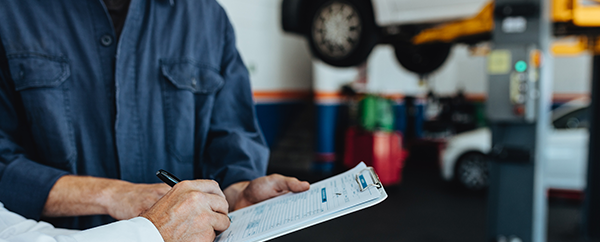Take steps to prevent these aftermarket customer liability risks
As an auto services shop owner, your clients keep a close eye on expenses – including their insurance. Help them keep premiums lower by taking steps to prevent these top aftermarket customer liability risks from happening at their shop.
Download the flyer with 10 tips here.
1. Distracted or inattentive driving. A tow driver who’s texting. A tech with a handheld diagnostic tool that’s distracting him while he test drives a vehicle, resulting in an incident.
Solution: Hire workers with clean MVRs. Train and monitor their driving. Download the risk management sheet to view more hiring and training tips.
2. Negligent repairs. A tech left the drain plug loose after an oil change or installed the wrong filter. Or that new tech, nursing a hangover, inadvertently used the wrong part.
Solution: Be careful who you hire. Use an in-depth screening process that includes a drug test and calls to former employers. Have clear job descriptions and workplace rules and apply them consistently across the board.
Related: Aftermarket loss prevention best practices
3. Slips & falls. A customer catches his foot on fraying carpet in your waiting area and falls. A car owner slips on an oil spill in the back.
Solution: Train staff what to do if a customer is hurt. Medical care should quickly be provided. Customers treated indifferently are more likely to sue. Schedule a once or twice a week walk-through, looking for problem areas including lighting, housekeeping, floors, doormats, spills, walkways and more.
4. Customer vehicle security. After a test drive, your tech parked a vehicle in an unsecure alley, or left the keys in the vehicle.
Solution: Instruct employees that all vehicles must be parked securely. All keys should be locked in a safe at night and inaccessible to all but the tech during the day. Post signs reminding customers that this business will not be held responsible for personal articles left in the vehicles.
5. Your customer’s business interruption. Your tech was negligent in his repairs, resulting in an inoperable delivery vehicle, costing your customer in missed sales.
Solution: Careful hiring, consistent monitoring of techs, enacting a checks system where a more experienced tech or manager approves the repair.
6. Repairs being completed without authorization. A customer requested an oil change. Your tech sees that the differential oil needs changing and does so without getting the owner’s permission. The customer now has an unexpected $300 bill.
Solution: Require techs to always – without exception – get approval on additional work, ideally in writing such as an email or text. If incidents are on the rise, monitor who the tech is on these incidents, and put a stop to it.
Related: New Automotive Aftermarket value-added services for producers and their clients
7. Vehicle depreciation or diminished value due to inferior repair or accident. A tech, test-driving a vehicle, is involved in a collision. The vehicle now has collision history. Or a body shop installs a quarter panel improperly, and the fit and finish are noticeably out of alignment.
Solution: At the risk of sounding like a broken record, it all goes back to the hiring and training of your techs, and having an experienced tech check each job before it’s marked complete.
8. Product liability resulting from poor workmanship. A tire store tech, changing a tire, doesn’t use a torque wrench to tighten lug nuts. The wheel comes off 30 miles down the road.
Solution: Continue to monitor the work of your techs, especially your newer, inexperienced ones. Pair them with a more experienced tech who will watch and correct any mistakes.
9. Lack of parts, delaying or compromising your work. Natural disasters such as COVID-19 or a strike can seriously delay accessibility of parts. A few months back, major auto manufacturers were shut down due to COVID, as were parts suppliers.
Solution: Call the owner and explain that OEM parts are not available; however, aftermarket parts are available. Provide information on the quality and endurance of the aftermarket part and note it on the repair estimate and repair order.
10. Coronavirus contagion. A tech or a previous customer unknowingly infects your waiting area or another customer.
Solution: You know the rules: Customers must wear a mask. Techs who talk with customers must wear masks. Rope off seating so that customers keep a six-foot distance. Increase your cleaning and sterilization of waiting areas and restrooms.
Related: Automotive shop safety orientation how-tos
In seeking to control aftermarket customer liability risks – whether product liability or GL – if you can provide evidence that you took your responsibility seriously, making reasonable efforts to prevent harm to others, you’re in a much better position to defend allegations of liability.
Evidence can be in a variety of forms, depending on the nature of the aftermarket customer liability risk, says Insurance Information Institute. A few examples are:
- Copies of communications with your customers or employees about safety and risk
- Testimony that you provided warning signs or other warning signals regarding a hazardous condition on your property
- Records of your efforts to verify that someone you hired was not a risk to others
- Evidence from other professionals in your field that the decisions you made and actions you took were consistent with acceptable professional standards
- Records that your equipment was regularly serviced by knowledgeable technicians
Note that most of these rely on some form of written record. Documenting your efforts can be vital to proving that you are not liable.
These top 10 aftermarket customer liability risks and claims were provided by our claims management group, to help you pinpoint specific issues that your shop may be facing. If you need help, we’re happy to provide additional risk management information.
Download the top 10 customer liability tipsheet here. You can add your contact information and share it with your customers and prospective clients.

